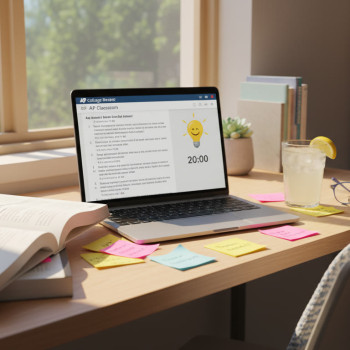Why parent communities matter for Digital SAT success
There’s nothing small about the role parents and caregivers play in college preparation. The Digital SAT shifted some technical and logistical pieces of the process, but the heart of success—steady practice, emotional support, and smart resource-sharing—hasn’t changed. When parents form communities that coordinate, share knowledge, and lean on one another, students get more than materials: they get structure, motivation, accountability, and confidence.

What makes a parent community effective?
Effective parent communities aren’t just message threads with links. They’re systems built around a few simple principles: clarity (who does what), accessibility (resources that are easy to use), sustainability (manageable commitments), and student-centeredness (what helps the learner most). With those pillars, sharing becomes a multiplier: a single high-quality practice test or a clear timetable can lift dozens of students rather than just one.
Get organized: simple structures that actually work
Good intentions need systems. Here are practical structures you can set up quickly that keep information flowing and reduce duplication.
1. A central repository
Create one place where everyone can upload and find documents: practice test PDFs, links to Bluebook practice tests, sample study plans, and notes from group workshops. This could be a shared cloud folder or a school-hosted page. The point is to avoid five parents re-creating the same study timeline.
2. Role-based volunteers
Instead of everyone doing everything, divide tasks. Typical roles include:
- Resource Curator: finds and vets practice tests and official guides.
- Scheduling Lead: coordinates group practice sessions and test registration reminders.
- Technical Help: lists instructions to navigate Bluebook and device requirements.
- Communications Lead: sends weekly summaries and meeting notes.
3. A simple calendar
Put test dates, practice windows, and deadlines on a shared calendar. Include reminders for when to take a full-length adaptive practice test on Bluebook, when to review results in My Practice, and when to apply for accommodations, if needed. A visual timeline helps families plan around sports, AP exams, and holidays.
Share the right resources—quality over quantity
Not all materials are created equal. Focusing on official, adaptive, and feedback-rich resources saves time and yields better progress.
Official practice materials to prioritize
- Bluebook full-length adaptive practice tests: Practice in the same environment students will see on test day and get scored feedback to target weak areas.
- My Practice / Student Question Bank: Use results to generate focused practice sets based on actual missed skills.
- Practice test PDFs and scoring guides: Handy for paper practice sessions or for reviewing strategies together.
When you share resources, annotate them. A parent who has used Practice Test 4 might write: “Good for algebra focus; students found timing in math more forgiving than before.” Practical notes help others pick the right tool for their child’s needs.
How to run community study sessions that students want to attend
Ad hoc study halls can be hit-or-miss. Make sessions useful and popular by blending structure, variety, and student agency.
Format ideas
- Timed practice + group review: 45–60 minute timed section followed by a 30–45 minute collaborative review of the most missed questions.
- Skill workshop: rotate topics (reading comprehension strategies, data analysis, algebraic modeling) led by a volunteer who preps a short lesson and practice set.
- Mixed-grade peer tutoring: upperclassmen who’ve recently scored well coach juniors or sophomores on specific question types.
Keep students in charge
Ask students what they need. Offer sign-ups for specific topics so participants feel the session is directly relevant. When students lead, buy-in rises and sessions become more lively.
Practical tools and how to use them
Technology is a powerful partner if communities use it intentionally. Below is a compact guide to useful tools and how parent groups can apply them.
| Tool | Best use in a parent community | Practical tip |
|---|---|---|
| Bluebook | Full-length adaptive practice tests and test preview. | Schedule at least one timed Bluebook run per month in the 3–4 months before a target test date. |
| My Practice / Student Question Bank | Generate targeted practice sets based on practice test performance. | Share how to export or screenshot question-bank outcomes for tutors to review and tailor sessions. |
| Shared cloud folder | Central repository for PDFs, study plans, and templates. | Organize by topic and label by grade/semester so files are easy to scan. |
| Group calendar | Coordinate practice sessions, test dates, and registration deadlines. | Use color-coding: practice tests (red), workshops (blue), deadlines (orange). |
Technical readiness checklist for Digital SAT
- Device compatibility and charger on test day.
- Practice with Bluebook to get comfortable with adaptive format and tools like markup and flagging.
- Backup plan: for school-based testing, know what the proctors provide and how to get technical help on test day.
Designing shared study plans that work
Study plans in parent communities should balance realism and ambition. A good shared plan becomes a template families can adapt to their schedules and students’ baseline scores.
A sample 12-week study template
Below is a community-friendly template parents can copy into the shared repository and personalize.
- Weeks 1–2: Diagnostic practice test in Bluebook + score review in My Practice. Identify top 2–3 weak areas.
- Weeks 3–6: Foundational skill blocks (two 45-minute sessions per week): one math focus, one reading/writing focus. Monthly full-length practice test at the end of Week 6.
- Weeks 7–9: Targeted practice using Student Question Bank sets + timed section practice. Group workshop on pacing strategies.
- Weeks 10–11: Dress-rehearsal tests—simulate test day with Bluebook (device charged, quiet room). Review mistakes together and make last-minute targeted tasks.
- Week 12: Light review, sleep, and logistical checks (test day route, ID, permitted items).
Harnessing collective strengths: peer tutoring, mentorship, and parent-led classes
Peer help can be a game-changer: it’s cost-effective, relatable, and often boosts confidence in ways adults can’t. Parent communities can formalize this in a few low-friction ways.
How to run a peer tutoring program
- Recruit top-performing upperclassmen and provide a short orientation for them about teaching strategies and boundaries.
- Match tutors to tutees based on specific need (e.g., geometry tutoring vs. evidence-based reading).
- Offer small stipends, community service hours, or gift cards as appreciation.
When to bring in expert help
Peer and parent-led efforts are powerful, but some students benefit from tailored, expert guidance. Personalized tutoring—like Sparkl’s 1-on-1 coaching—fits naturally here: communities can subsidize or recommend occasional expert sessions to pinpoint test-taking habits, refine strategies, or build confidence. The right tutor translates practice-test feedback into practical next steps and creates a custom study plan that respects a student’s other commitments.
Keeping equity front and center
One of the most meaningful things a parent community can do is ensure access. Equitable support means thinking beyond materials to consider time, cost, transportation, and language barriers.
Practical equity solutions
- Share a budget-friendly resource list that highlights free official practice tests and practice tools.
- Create a loaner device program for students who don’t have a compatible device for Bluebook practice.
- Offer sessions at varied times (evenings, weekends) and record brief debriefs or study summaries for those who can’t attend.
- Organize volunteer rides or carpooling for weekend practice sessions and test-day transport.
Tracking progress without stress
Data can inspire or intimidate. Parent groups should use results to encourage growth, not to apply pressure.
Healthy metrics to track
- Number of timed practice tests completed in Bluebook each month.
- Specific skill improvements from My Practice (e.g., percent correct in algebraic problem solving).
- Consistent study time per week (minutes), not just raw scores.
- Student-reported confidence and stress levels—surveyed monthly.
How to run a quick, encouraging score review
After a practice test: focus on one or two growth goals, celebrate progress (even small improvements), and create a short action item list. For example: “Improve data-interpretation speed by practicing two 15-minute sets this week.” Short, achievable steps preserve momentum.
Examples from the real world: community strategies that scale
Here are a few replicable models parent communities have used successfully—each balances shared effort with individualized benefit.
Model A: The Rotation Workshops
Parents and volunteer teachers lead weekly 60–90 minute workshops on focused topics. Each workshop is recorded and summarized in the central repository. Students sign up for topics, creating a modular system where learners customize their path.
Model B: Buddy System + Monthly Mock Test
Students are paired with a study buddy (often one grade apart) and commit to two 30-minute sessions per week plus one community mock test each month. Parents rotate supervision duties for the monthly mock and share a short report highlighting common issues.
Model C: Hybrid—Peer Tutors + Occasional Expert Sessions
Peer tutors handle weekly practice and quick reviews, while the community pools funds for one or two sessions per semester with an expert tutor who provides skill audits and personalized plans. Sparkl’s personalized tutoring, with AI-driven insights and 1-on-1 coaching, can be one of the expert options families turn to for targeted interventions when practice plateaus.
Addressing common barriers and myths
Communities also serve to debunk myths and reduce anxiety. Here are common concerns and realistic responses.
“My child needs to study 8 hours a day.”
Quality beats quantity. Short, focused sessions with clear goals outperform marathon sessions. Two to three deliberate practice blocks a day (25–60 minutes each), combined with periodic full-length practice tests, is usually better.
“Only private expensive tutoring helps.”
Not true. Many students succeed with a mix of free official resources, structured peer practice, and targeted expert sessions when necessary. Communities can help subsidize or identify the best moments to invest in a paid tutor.
“Digital testing is confusing—my teen will be at a disadvantage.”
The adaptive digital format changes pacing and navigation, but these are learnable. Regular Bluebook practice demystifies the interface and adaptive behavior, and community run-throughs of the test preview reduce test-day anxiety.
How parents can support without taking over
Parental involvement is crucial, but it should empower rather than control. The best support looks like steady scaffolding: organizing, encouraging, and protecting time for focused study, while letting students take ownership of the work.
Do’s and don’ts for parents
- Do create structure: shared calendars, regular practice windows, and logistics checks for test day.
- Don’t micromanage scores: help interpret results and set growth goals, but let students lead their study routines.
- Do encourage balanced life: sleep, exercise, and breaks are part of good preparation.
- Don’t use practice tests as judgment tools: they’re instruments for learning.
Measuring success beyond the score
Yes, scores matter for admissions—yet success includes stronger time-management skills, resilience, and improved academic habits. Parent communities should track and celebrate these softer outcomes as much as numerical growth.
Celebration ideas
- Highlight student progress in a monthly newsletter (effort spotlight, not just top scorers).
- Host a low-key celebration after a major test window—snacks, recognition certificates, and volunteer thank-yous.
- Create a “skills badge” system for milestones: consistent practice, completing a Bluebook test cycle, or improving on a specific skill area.
Next steps: a one-month action plan for your parent community
If your group is starting from zero, here’s a simple, practical plan you can start this week.
- Week 1: Form a small leadership team and set up a shared folder and calendar. Post a short survey asking students what they need most.
- Week 2: Schedule two community events: an orientation on Bluebook and a 60-minute skills workshop. Recruit peer tutors and volunteers.
- Week 3: Run a community-wide diagnostic Bluebook practice test and collect results into a shared spreadsheet. Identify common weak areas.
- Week 4: Launch weekly workshops and pair students with buddies or tutors. Publish a two-month schedule and celebrate the launch with a quick virtual or in-person kickoff.
Final thoughts: small steps, big impact
Building a supportive parent community for Digital SAT prep is less about having all the answers and more about creating systems where answers can be found and tested together. A shared calendar, a well-organized resource hub, rotating volunteer roles, and a willingness to combine peer support with targeted expert tutoring (including options like Sparkl’s personalized 1-on-1 guidance that pairs human expertise with AI-driven insights) create a safety net where students can practice, fail, learn, and grow. Communities reduce duplication, cut costs, and—most importantly—give students the emotional and logistical scaffolding they need to reach their potential.
Start small, share freely, and keep the focus on learning and well-being. When parents work together, they don’t just pass along study materials—they pass along confidence, perspective, and a clearer path to college and beyond.
















No Comments
Leave a comment Cancel